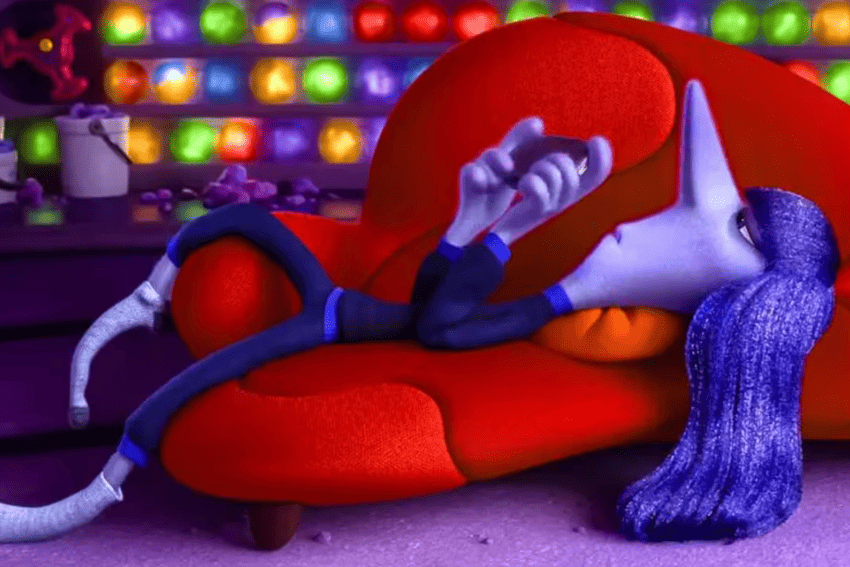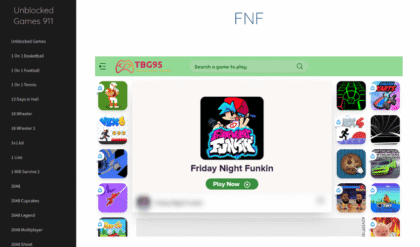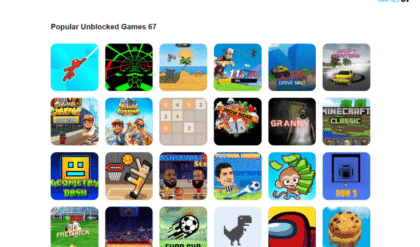Introduction to Inside Out 2 Glued to Phone
In Inside Out 2, Pixar introduces us to a new emotion, ennui, which perfectly represents the modern teenage experience of constantly scrolling phones. As Riley goes through the tumultuous period of adolescence, Ennui is depicted as a bored individual who spends most of time glued to her phone, symbolizing the struggles many people face in today’s hyper-connected world. But why is Ennui so glued to her phone?

This article delves into the story, psychology, and cultural interpretation behind ennui’s obsession with screens in Inside Out 2 and provides insight into how this new emotion reflects our relationship with technology.
Ennui: The Embodiment of Boredom
Ennui, voiced with deadpan brilliance in Inside Out 2, represents boredom that is all too familiar in the age of endless notifications and social media feeds. Her character design, complete with a slouched posture and half-lidded eyes, screams disinterest, yet her phone is her constant companion. This contrast is no accident. Pixar uses Ennui to mirror how boredom paradoxically drives us to seek distraction through our devices, only to deepen our sense of detachment.
In the film, Ennui’s phone is not just a prop. It is an extension of her character. It symbolizes the modern reflex to fill every quiet moment with scrolling, swiping, or tapping. Whether she is lounging in the control room of Riley’s mind or casually dismissing the other emotions, her screen time highlights a key theme: technology can amplify emotional states, especially ones tied to disengagement.
The Psychology of Phone Addiction in Inside Out 2
Why is Ennui glued to her phone? The answer lies in the psychology of boredom and its connection to smartphone use. According to psychologists, boredom is a state of vulnerability that leads us to seek out novelty. In Inside Out 2, Ennui’s phone is an endless source of novelty—or at least, the illusion of it. Social media, games, and videos provide an instant rush of dopamine, but they rarely fulfill deeper emotional needs.
The film cleverly shows how Ennui’s phone use isolates her from the other emotions, like Joy, Sadness, and Anxiety. Her scrolling creates a barrier, keeping her from fully engaging in Riley’s challenges. This mirrors real-world studies, like those from the American Psychological Association, which suggest excessive phone use can reduce emotional regulation and increase feelings of loneliness. Pixar’s portrayal of Ennui nails this dynamic, making her both a comedic standout and a poignant commentary on our screen-addicted culture.
Technology as a Coping Mechanism
In Inside Out 2, Ennui’s phone is not just about boredom. It is a coping mechanism. As Riley faces new pressures, like fitting in at school and grappling with her identity, Ennui’s apathy reflects a desire to check out from overwhelming emotions. Her phone becomes a shield, a way to avoid the messiness of adolescence. This resonates with anyone who is ever doom-scrolled to escape stress or anxiety.
Pixar does not shy away from showing the downsides of this behavior. Ennui’s detachment sometimes leaves Riley stuck, unable to process her feelings fully. The film suggests that while technology offers a temporary escape, it cannot replace the hard work of confronting emotions head-on. Through Ennui, Inside Out 2 asks us to reflect on our own phone habits: Are we using our devices to connect or to disconnect?
Cultural Commentary: Phones and the Teenage Experience
Inside Out 2 is not just about Riley. It is a snapshot of modern adolescence. Ennui’s phone obsession taps into a broader cultural truth: smartphones are central to how teens (and adults) navigate their world. From social media pressures to the constant need for validation, phones shape our emotions in ways we don’t always recognize. Ennui’s character captures this perfectly, with her sarcastic quips and endless scrolling serving as a mirror to our own habits.
The film also highlights the generational divide. While Joy and the original emotions struggle to understand Ennui’s phone fixation, it is second nature to Riley. This reflects how younger generations, raised with smartphones, see them as integral to their identity. Inside Out 2 does not judge this reality but invites us to question how much control we give our devices over our emotional lives.
Ennui’s Role in Riley’s Emotional Growth
Without spoiling too much, Ennui’s phone-glued nature is not just a quirk. It plays a pivotal role in Riley’s journey. Her apathy, amplified by her screen time, forces the other emotions to confront their own limitations. In a way, Ennui’s detachment pushes Riley toward growth, showing that even “negative” emotions like boredom have value. Her phone, while a source of distraction, also becomes a catalyst for deeper self-awareness in the story.
This nuanced portrayal is classic Pixar. Inside Out 2 does not demonize technology but shows its dual nature—both a tool for connection and a potential trap for disconnection. Ennui’s arc reminds us that balance is key, and stepping away from the screen can open the door to richer emotional experiences.
Why Ennui Resonates with Audiences
Ennui’s phone obsession strikes a chord because it is so relatable. Who has not felt the pull of a notification or lost an hour to mindless scrolling? In Inside Out 2, her character holds a mirror up to our own habits, asking us to consider why we reach for our phones when we are bored, anxious, or disconnected. Her deadpan humor and eye-rolling attitude make her a fan favorite, but her deeper message lingers technology can amplify our emotions, but it is up to us to decide how much power it holds.
Final Thoughts
Inside Out 2 uses Ennui to deliver a heartfelt and timely exploration of phone addiction, boredom, and emotional growth. Her constant scrolling is not just a funny gag. It is a window into the challenges of living in a digital age. By blending humor, heart, and sharp cultural commentary, Pixar reminds us that while phones are part of our lives, they do not have to define our emotions. Next time you catch yourself glued to your screen, channel a little Joy and step away—your inner Riley might thank you.





